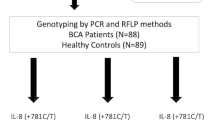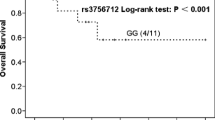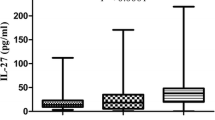Abstract
Background
Dysregulation of apoptosis plays a crucial role in carcinogenesis. Our aim was to investigate the association of Caspase 9 and Caspase 8 gene polymorphism with bladder cancer (BC) susceptibility.
Methods
We undertook a case–control study of 212 (BC) cases and 250 controls to investigate the association between Caspase 9-1263A > G, Caspase 9-293del, and Caspase 8-6 N ins/del polymorphism and BC susceptibility by polymerase chain reaction (PCR) restriction fragment length polymorphism (RFLP) method, and further to study the influence on recurrence in patients after Bacillus Calmette–Guerin (BCG) immunotherapy.
Results
Overall, no statistically significant association was observed in Caspase 9-293del and Caspase 8. Nevertheless, Caspase 9-1263GG genotype was at reduced risk of BC [p = 0.010; odds ratio (OR) = 0.487]. Caspase 9-1263AG genotype was also observed to be significantly associated with reduced risk with high-risk non-muscle-invasive bladder cancer (NMIBC) (TaG2-3, T1G1-3) and invasive tumors (T2 +) of BC (P = 0.042, OR = 0.39 and P = 0.013, OR = 0.028 respectively). Caspase 9-293del, heterozygous (–/+) genotype, too, demonstrated protective effect in high-risk NMIBC (P = 0.017; OR = 0.205). Haplotype analysis revealed variant genotypes Caspase 9AG + GG/Caspase 8 DI + II to be at reduced risk of BC (= 0P.014, OR = 0.47). The GG genotype of Caspase 9-1263 was associated with reduced risk for recurrence in BCG-treated patients [hazard ratio (HR) = 0.217, P = 0.005], thus showing increased recurrence-free survival (log-rank P = 0.024).
Conclusion
Polymorphism in Caspase 9-1263 was observed to play a protective role in susceptibility to BC risk. Caspase 9 gene variants were also associated with reduced risk of NMBIC stages. The variant G allele at Caspase 9-1263 may be responsible for increased recurrence-free survival in BCG-treated patients.

Similar content being viewed by others
References
Ibrahim AS, Khalid HM. Urinary bladder cancer, Mecc Monograph, Chapter 11, 2006:97–109, National Cancer Institute, Bethesda, MD.
Takagi Y, Takashi M, Koshikawa T, Ohshima S. Immunohistochemical demonstration of cyclin D1 in bladder cancers as an inverse indicator of invasiveness but not an independent prognostic factor. Int J Urol. 2000;7:366–72.
Wagner U, Suess K, Luginbuhl T, Schmid U, Ackermann D, Zellwegener T. Cyclin D1 overexpression lacks prognostic significance in superficial urinary bladder cancer. J Pathol. 1999;188:44–50.
Bevers RFM, Kurth KH, Schamhart DHJ. Role of urothelial cells in BCG immunotherapy for superficial bladder cancer. Br J Cancer. 2004;91:607–12.
Vaux DL, Cory S, Adams JM. Bcl-2 gene promotes haemopoietic cell survival and cooperates with c-myc to immortalize pre-B cells. Nature. 1988;335:440–2.
Lockshin RA, Zakeri Z. Programmed cell death and apoptosis: origins of the theory. Nat Rev Mol Cell Biol. 2001;2:542–50.
Hockenbery D, Nuñez G, Milliman C, Schreiber RD, Korsmeyer SJ. Bcl-2 is an inner mitochondrial membrane protein that blocks programmed cell death. Nature. 348,334-336.
Fennell DA. Caspase regulation in non-small cell lung cancer and its potential for therapeutic exploitation. Clin Cancer Res. 2005;11:2097-2105.
Hengartner MO. The biochemistry of apoptosis. Nature. 2000;407:770–6.
Kaufmann SH, Gores GJ. Apoptosis in cancer: cause and cure. BioEssays. 2000;22:1007–17.
Park JY, Park JM, Jang JS, Choi JE, Kim KM, Cha SI, et al. Caspase 9 promoter polymorphisms and risk of primary lung cancer. Hum Mol Genet. 2006;15:1963–71.
Sun T, Gao Y, Tan W, Ma S, Shi Y, Yao J, et al. A six-nucleotide insertion-deletion polymorphism in the CASP8 promoter is associated with susceptibility to multiple cancers. Nat Genet. 2007;39:605–13.
Colombel M, Soloway M, Akaza H. Epidemiology, staging, grading and risk stratification of bladder cancer. Eur Urol Suppl. 2008;7:618–26.
Miller SA, Dykes DD, Polesky HF. A simple salting out procedure for extracting DNA from human nucleated cells. Nucl Acids Res. 1988;16:1215.
Larsson P, Wijkström H, Thorstenson A, Adolfsson J, Norming U, Wiklund P, et al. A population-based study of 538 patients with newly detected urinary bladder neoplasms followed during 5 years. Scand J Urol Nephrol. 2003;37:195–201.
Thatte U, Dahanukar S. Apoptosis: clinical relevance and pharmacological manipulation. Drugs. 1997;54:511–32.
Kelly JD, Williamson KE, Irvine AE, Hamilton PW, Weir HP, Anderson NH, et al. Apoptosis and its clinical significance for bladder cancer therapy. BJU Int. 1999;83:1–10.
Twiddy D, Cain K. Caspase-9 cleavage, do you need it? J Biochem. 2007:405.
Haiman CA, Garcia RR, Kolonel LN, Henderson BE, Wu AH, LeMarchand L. A promoter polymorphism in the CASP8 gene is not associated with cancer risk. Nat Genet. 2008;40:259–60.
Pittman AM, Broderick P, Sullivan K, Fielding S, Webb E, Penegar S, et al. CASP8 variants D302H and-652 6 N ins/del do not influence the risk of colorectal cancer in the United Kingdom population. Br J Cancer. 2008;98:1434–6.
Wang M, Zhang Z, Tian Y, Shao J, Zhang Z. A six-nucleotide insertion-deletion polymorphism in the CASP8 promoter associated with risk and progression of bladder cancer. Clin Cancer Res. 2009;15:2567–72.
Frank B, Rigas SH, Bermejo JL, Wiestler M, Wagner K, Hemminki K, et al. The CASP8 -652 6 N del promoter polymorphism and breast cancer risk: a multicenter study. Breast Cancer Res Treat. 2008;111:139–44.
Acknowledgment
The study was supported by a grant from the Department of Science and Technology, New Delhi, Govt. of India. R.G. is grateful to the Council of Scientific and Industrial Research, New Delhi for a JRF.
Author information
Authors and Affiliations
Corresponding author
Rights and permissions
About this article
Cite this article
Gangwar, R., Mandhani, A. & Mittal, R.D. Caspase 9 and Caspase 8 Gene Polymorphisms and Susceptibility to Bladder Cancer in North Indian Population. Ann Surg Oncol 16, 2028–2034 (2009). https://doi.org/10.1245/s10434-009-0488-3
Received:
Revised:
Accepted:
Published:
Issue Date:
DOI: https://doi.org/10.1245/s10434-009-0488-3




